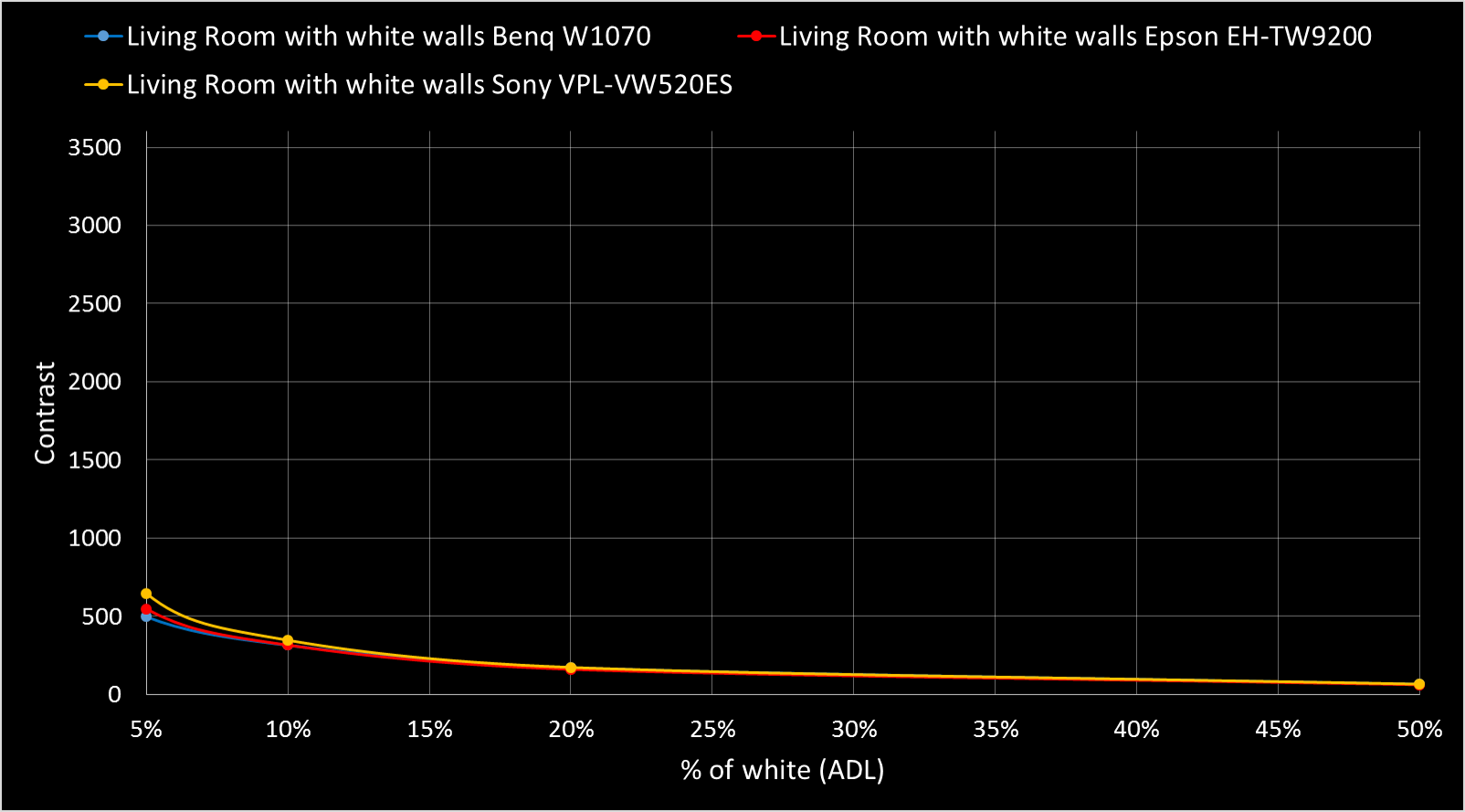El ADL debería ser el valor a tener en cuenta, en lugar del APL, al menos si somos coherentes con la idea de que los proyectores se han de comprara una vez calibrados, y el valor gamma sobre el que hay consenso en FullHD es 2.2.
Esa gráfica ofrece datos de contraste de los proyectores tope de gama de Epson, los cuales multiplican decenas de veces el valor ofrecido por un DLP, no tiene sentido utilizar estos datos con ejemplo de una comparativa entre un LCOS y DLP.- Fíjate en esta gráfica de los mismos que han calculado el ADL de tu enlace:
Pincha en esta barra para ver la imagen original de 763x408px.
Epson EH-TW9300, EH-TW7300, EH-LS10000: The Battle! - ProjectionDream.com
-Qué diferencia de contraste ON/OFF hay entre esos dos proyectores? ... porque la realidad es que muestra con claridad que desde un ADL de sólo el 4% hacia arriba hay bien poca diferencia entre ellos en cuanto contraste (en una buena zona del %ADL por encima de ese 5% ganando además el que tiene más ANSI y menos ON/OFF).
Esta gráfica de projectiondream.com concuerda perfectamente con lo que medimos y veíamos entre el HC4000 y el JVC en la batcave de mach16 en la prueba que colgué en este hilo (si le echas un vistazo a los 15 frames que analizamos, donde el JVC sólo ganó con claridad en los MUY, MUY oscuros: en los que midió entre x5 y x3 más de contraste real... en el resto d oscuras pues ya dependendía de cómo estuviera repartido el % de la zonas iluminadas vs las más negras, donde en la mayoría de escenas la diferencia medida no era nada exagerada... y aunque visiblemen era pero "poco").
Y por último esta otra gráfica del mismo enlace:
Lo que viene a decir es que en sala con paredes blancas cae tanto el contraste desde un %ADL tan bajo ( y eso se da en cualquier proyector), que entre un DLP y un JVC "apenas" habría diferencia (probablemente sólo las de 1% ADL hacia abajo aún marcaran alguna diferencia)... viéndose un proyector como todo un JVC en sala de paredes blancas menos contrastado en casi todos los frames que un DLP de calidad media en batcave (luego en proyección la sala es sin dudas lo primero en donde todos aficionado debería EMHO invertir).
Para ilustrar los efectos de una sala no dedicada en proyección, dado que el objeto del hilo es DLP vs JVC, las gráficas correctas son otras, donde se reflejan los resultados del entorno de proyección en las diferentes tecnologías:
¿Y que vemos en ellas?, pues muy sencillo, que incluso en sala no dedicada, las diferencias en ADL inferiores al 20% siguen siendo perceptibles.
Cabe recordar, que de media, un valor entre 0% y 20% de ADL, corresponde a un altísimo número de films:
The native contrast (ON-OFF) contrast stays unchanged while projecting in a room optimized or with white walls AS LONG AS no other lights enter the room (windows, ceiling, candle, smartphone etc…)
The 1% white contrast drops a lot more in the “room with white walls” than in an optimized room. However, if we compare the Benq W1070 and the Sony VPL-VW520ES, there is still quite a world between them, EVEN in the room with white walls.
In the optimized room: the Sony VPL-VW520ES has 6 times the contrast of the Benq W1070
In the room with white walls: the Sony VPL-VW520ES has still 2.5 times the contrast of the Benq W1070
For the 2% white contrast, the difference is still large between the “low end” and “very high end” projector even in a white room:
In the optimized room: the Sony VPL-VW520ES has 4.4 times the contrast of the Benq W1070
In the room with white walls: the Sony VPL-VW520ES has still 1.7 times the contrast of the Benq W1070
For the 5% white contrast, the difference is still large between the “low end” and “very high end” projector in an optimized room, but not so much in a white room:
In the optimized room: the Sony VPL-VW520ES has 2.9 times the contrast of the Benq W1070
In the room with white walls: the Sony VPL-VW520ES has 1.3 times the contrast of the Benq W1070
For the 10% white contrast, the difference is still large between the “low end” and “very high end” projector in an optimized room, but almost not existent in a white room:
In the optimized room: the Sony VPL-VW520ES has 2.1 times the contrast of the Benq W1070
In the room with white walls: the Sony VPL-VW520ES has 1.1 times the contrast of the Benq W1070
For the 20% white contrast, there is still a difference between the “low end” and “very high end” projector in an optimized room, but the contrast is the same in the white room (170:1):
In the optimized room: the Sony VPL-VW520ES has 1.6 times the contrast of the Benq W1070
In the room with white walls: the Sony VPL-VW520ES has 1.0 times the contrast of the Benq W1070
For the 50% white contrast, there is still a difference between the “low end” and “very high end” projector in an optimized room, but the ANSI contrast is the same in the white room (67:1):
In the optimized room: the Sony VPL-VW520ES has 1.6 times the contrast of the Benq W1070
In the room with white walls: the Sony VPL-VW520ES has 1.0 times the contrast of the Benq W107
Con estos datos, a mi entender queda demostrado, que en sala no dedicada, las diferencias entre proyectores DLP y proyectores 3cd de gama media/alta y LCOS, siguen siendo evidentes, lo suficiente como para justificar el mayor desembolso económico que suponen. Luego están las valoraciones económicas que cada cual haga, habrá quien crea conveniente un mayor desembolso económico para obtener ese plus de contraste, y habrá quien crea que es tirar el dinero, ambas posiciones totalmente legitimas, pero el hecho es que si hablamos de contraste, las diferencias en sala no dedicada existen.You can always compare with this distribution of the picture brightness found in movies:
90% of all movie pictures have a brightness below 20% (ADL=% of white)
80% of all movie pictures have a brightness below 13%
50% of all movie pictures have a brightness below 5%
The average brightness/ADL of all analyzed movies is 8%
Saludos.




 LinkBack URL
LinkBack URL About LinkBacks
About LinkBacks








